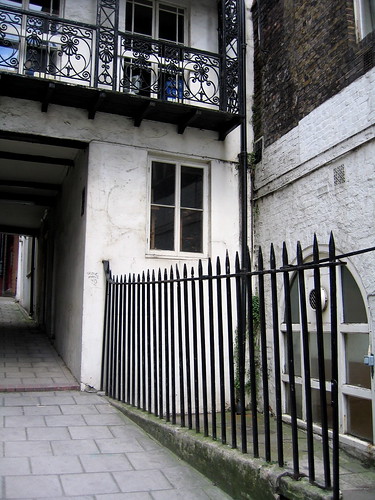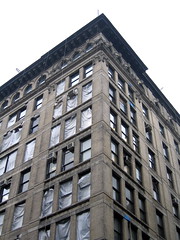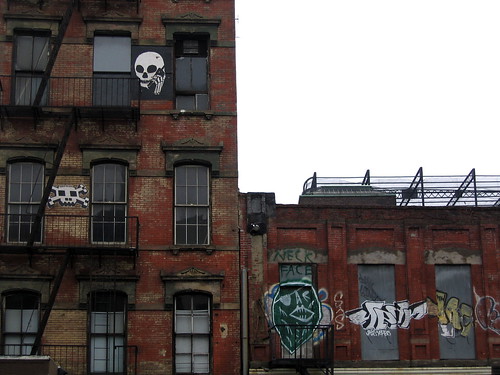Monday, January 31, 2005
London: Roman Baths

An American once told me in Vienna that the Strand possesses a Roman bath well worth seeing, but, being a good Londoner, I did not believe him -- until I went there.O credulous Morton! Architectural critic Nikolaus Pevsner(page 371 -- The Buildings of England: London and Westminster Simon Bradley and Nikolaus Pevsner. Yale), for one, thinks this unlikely: "David Copperfield took a cold plunge in it before setting off to walk to Hampstead." which is all very well, but he's fictional. "The dimensions of the bricks are not Roman, and the high ground level also rules out a Roman origin. More likely is that the bath belonged with ARUNDEL HOUSE, which would suggest a C16 or early C17 date." Case closed. So what you have in this back alley off the strand, is merely a 16th century bath -- an era not noted for bathing -- built by some aristocratic collector of antiquities. It dosn't really matter who built it. Its weird enough to find the alley with the bath. Its owned by the National Trust (check the link for directions etc.), but it is unattended. You push a light switch on a timer and peer down into what looks like a flooded basement (well lit, made of a khaki sandstone). It makes you wonder what's hidden around the next corner, what building has a lightswitch on it so you can peer inside. It is fantastic.
This Bath, which was constructed in A.D. 200 -- seventeen hundred years ago -- is opposite Bush House, in the Strand. Think of that. bush house and Rome! It is in the basement of No. 5 Strand Lane, an astonishing, a narrow, dingy alley that, in one step, takes you back to the darkest days of Victorian London, when lanterns glimmered in passages and 'Peelers' twirled truncheons and wore stove-pipe hats. No. 5 belongs to the Rev/ pennigton Bickford, Rector of St. Clement Danes, who bought the house a few years ago to save the bath, which was - O incredible London! - in danger of destruction.
Page 143 - Our Roman Bath. Notes from London by H.V. Morton - fifth edition, Methuen and Co, Ltd. London 1941
My friend Ben Chant, in his as yet unpublished Liars Guide to London (copyright Benedict Chant) imagines that the Roman Bath is part of a ancient Temple complex. Here he describes a visit:
Turn left out of the cafe and walk up Arundel Street until you reach Temple Place on your left. This is the site of the spectacular Roman Temple that gave the area its name. Follow the lane round to the right and ring the bell. The Temple is open from 9:00 a.m. to 9:00 p.m., but it's frequently rented out in the evenings to parties of lawyers and business people from the nearby Inns of Court or the City, so call ahead if you are planning to arrive after 6:00 p.m. The National Trust looks after the temple so there's no admission fee, just the venerable custodian standing next to a collection box as you enter. If you do donate something you'll find the staff eager to give you an informal tour. You should probably do this because although the temple appears to be simply designed (it was merely the "private chapel" of a minor Roman official), your guide can point out some peculiar details. Note, for example, the mosaics of exceptionally priapic rams and dolphin-boys playing in the water. The story goes that there is a room in the back of the temple with wall paintings that match the licentiousness of Pompeii's frescoes, but I have never been able to donate enough money to pry a definite "yes" or "no" from the guides.
Monday, January 17, 2005
Wonderful Saloon

To a devoted McSorley customer, most other New York City saloons are tense and disquieting. It is possible to relax in McSorley’s. For one thing, it is dark and gloomy, and repose comes easy in a gloomy place. also, the barely audible heartbeatlike ticking of the old clocks is soothing. Also, there is a thick, musty smell that acts as a balm to jerky nerves; it is really a rich compound of the smells of pine sawdust, tap drippings, pipe tobacco, coal smoke, and onions. A bellevue intern once remarked that for some mental states the smell in McSorely’s would be a lot more beneficial than psychoanalysis or sedative pills or prayer. - The Old House at Home from McSorely’s Wonderful Saloon collected in Up in the Old Hotel by Joseph Mitchell. Pantheon, New York, 1992.
Until the 1970's (when, conincidently, the Swiss finally allowed women to vote) McSorely's refused to serve women their ale. Such is the way of small landlocked nations. It's probably Joseph Mitchell's fault as much as anybodys, but the peaceful bar he describes no longer exists. It looks the same, to be sure, but, on weekends, it full of loud beer enthusiasts obliterating history with their weird slogans (i.e. "fucking A!"). But go during the week, early in the day, and you'll get a sense of what made the place special. Of course, you'll be drinking -- early in the day, and in the middle of the week. Thats an excellent way to feel special in itself. Order ale two mugs at a time, but go easy on the cheese, onion and saltine platters.
Sunday, January 16, 2005
The Poor Man's Stork Club: 267 The Bowery

While I was there absorbing the atmosphere and drinks, a midget walked in. . .he was about three and a half feet. I invited him for a drink. He told me that he had just arrived from Los Angeles, where he had been working for Brown & William's Tobacco Co., walking the streets dressed as a penguin. The midget was flush and started buying me drinks. He proudly showed me his social security card, told me that he was thirty-seven years old, was single as the girls only after money, that once in a while he got some affection, but had to pay for it. . . .After the seventh round he got boisterous and offered to fight any man his size in the house. Sammy grabbed the midget and threw him out through the doorway which has a red neon sign saying “Thank you, call again,” hollering at him not to ever come back again. Sammy’s has a blacklist just like Billingsley’s Stork Club uptown.-- Naked City by Weegee (Arthur Fellig). Dacapo Press.

The ground floor contains one of the Bowery’s many kitchen supply stores. The upper floors look like they are being renovated--or dismantled. Bars had more or less left the Bowery by the early nineties (there was Pheobes, and CBGB’s, and Bowery Bar but nothing I can remember below Houston). Now they are coming back, upscale joints to go with the condos. There are a couple of missions left on the Bowery, but it takes a feat of imagination to conjure the world of the “poor mans stork club.”
Update: On October 5th, 2005 The NewYork Daily News ran a story by Elliot Rosenberg called "Last Stop Before Oblivion: Sammy's Bowery Folliers" on the last days of Sammy's on the Bowery and the aging vaudville performers who performed there. Great stuff.
Saturday, January 15, 2005
Shirtwaist Factory Fire

"And this also," said Marlow suddenly, "has been one of the dark places of the earth." -- Heart of Darkness by Joesph Conrad.
Another entry on the gruesome working conditions that existed for women in the early 20th century. The Brown building, on the intersection of Washington and Greene Streets, near Washington Square in Greenwich Village, is nowadays part of NYU, which uses it for office space and classrooms. It looks no different than many of the buildings surrounding it (although it appears to be in the midst of a renovation), but was once the scene of great horror.

In 1911 it was known as the Asch building, and was home to the Triangle Shirtwaist Factory. On the 25th March of that year, a fire started in the factory, on the eighth floor, and was quickly spread by the flammable materials used in clothing manufacture. With few exits, and those that existed blocked and locked, a large number of the almost exclusively female workforce were trapped. Many chose to jump out the windows rather than face the flames. Ultimately 146 Women died. The fire was witnessed by a large number of passersby, and the newspapers ran gruesome pictures of the dead. The public outcry at the disaster and the working conditions which led to the deaths of so many became the impetus for the successful efforts of the International Ladies’ Garment Workers’ Union to organize in the garment district.
There is a small plaque on the building commemorating the fire and the building's status as a landmark, but thousands of people must pass the building everyday without being aware of its history.
Facts and figures from the The Encyclopedia of New York City.1
1The Encyclopedia of New York City. Edited by Kenneth T. Jackson. Yale University Press. 1995.
Wednesday, January 12, 2005
McGurk's Suicide Hall

By popular accord, the very worst dive on the Bowery in the 1890’s was McGurk’s Suicide Hall, on the East Side just above Houston Street (the building is still standing), and it did not conduct its business in secrecy, since it possessed one of the first electric signs on the avenue. . . . . .Entertainment consisted of singing waiters and a small band; the customers were, as ever, mostly sailors. “It was said,” noted a contemporary, “that his business card reached every seaport in the world.” -- Low Life by Luc Sante.
The Hall got its nickname because of the many suicides which occurred there. In “1899, there were at least six, as well as more than seven attempts.” The victims were mostly the prostitutes who seem to be the main reason for the tavern’s existence.. It was a desperate place: none the less it became a morbid tourist attraction. I don’t know if the skull graffiti is a tribute to it’s past. I doubt it.






